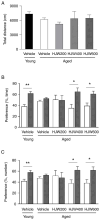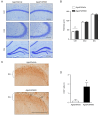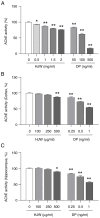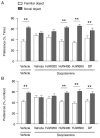Water extract of Humulus japonicus improves age‑related cognitive decline by inhibiting acetylcholinesterase activity and the acetylcholine signaling pathway
- PMID: 40116124
- PMCID: PMC11938412
- DOI: 10.3892/mmr.2025.13496
Water extract of Humulus japonicus improves age‑related cognitive decline by inhibiting acetylcholinesterase activity and the acetylcholine signaling pathway
Abstract
The aging process is associated with a decline in certain cognitive abilities, including learning and memory. This age‑related cognitive decline is associated with a reduction in neurogenesis and alterations in the cholinergic system. Humulus japonicus (HJ), an ornamental plant in the family Cannabaceae, has been reported to exert beneficial effects against neurodegenerative pathophysiologies in mouse models of disorders such as Alzheimer's and Parkinson's disease. Despite the increasingly aging populations of numerous societies, no study has yet investigated the effects of HJ on cognitive decline associated with normal aging. The present study therefore aimed to examine the protective potential of HJ water (HJW) extract against age‑related cognitive decline and scopolamine‑induced cognitive impairment. The analyses revealed that the oral administration of HJW markedly improved novel objective recognition and spatial learning in the novel object recognition and Morris water maze tests, respectively, in aged mice. The administration of 600 mg/kg HJW further increased neurogenesis and CA1 thickness in the hippocampi of aged mice. In scopolamine‑induced cognitive impairment, administration of 400 or 600 mg/kg HJW markedly increased novel object recognition performance in scopolamine‑treated mice. The inhibitory effect of HJW on acetylcholinesterase (AChE) and the activation effects of HJW on the calcium/calmodulin‑dependent kinase (CaMK)IIα‑cAMP response element‑binding protein (CREB) and AKT‑glycogen synthase kinase‑3 β (GSK3β) pathways were further demonstrated. Overall, these results indicate that HJW administration improves cognitive function through the regulation of AChE activity and CaMKIIα‑CREB and AKT‑GSK3β pathways.
Keywords: Humulus japonicus; acetylcholine; aging; cognitive function; scopolamine‑induced model.
Conflict of interest statement
Hyun-Ju Cho and Hong-Sik Kim are founders of NHB Co. and PENS Co. HJW was supplied by the NHB Co. and PENS Co. The other authors declare that they have no competing interests.
Figures








Similar articles
-
The Aqueous Extract of Humulus japonicus Ameliorates Cognitive Dysfunction in Alzheimer's Disease Models via Modulating the Cholinergic System.J Med Food. 2022 Oct;25(10):943-951. doi: 10.1089/jmf.2021.K.0197. Epub 2022 Sep 29. J Med Food. 2022. PMID: 36178947
-
Dracocephalum moldavica attenuates scopolamine-induced cognitive impairment through activation of hippocampal ERK-CREB signaling in mice.J Ethnopharmacol. 2020 May 10;253:112651. doi: 10.1016/j.jep.2020.112651. Epub 2020 Feb 6. J Ethnopharmacol. 2020. PMID: 32035879
-
Casticin ameliorates scopolamine-induced cognitive dysfunction in mice.J Ethnopharmacol. 2020 Sep 15;259:112843. doi: 10.1016/j.jep.2020.112843. Epub 2020 May 4. J Ethnopharmacol. 2020. PMID: 32380246
-
Aster glehni Extract Ameliorates Scopolamine-Induced Cognitive Impairment in Mice.J Med Food. 2019 Jul;22(7):685-695. doi: 10.1089/jmf.2018.4302. Epub 2019 Jun 21. J Med Food. 2019. PMID: 31225769
-
6,7,4'-Trihydroxyisoflavone, a major metabolite of daidzein, improves learning and memory via the cholinergic system and the p-CREB/BDNF signaling pathway in mice.Eur J Pharmacol. 2018 May 5;826:140-147. doi: 10.1016/j.ejphar.2018.02.048. Epub 2018 Mar 3. Eur J Pharmacol. 2018. PMID: 29510125
Cited by
-
Regulating astrocytic activity in the dorsal striatum mitigates L-dopa-induced dyskinesia in Parkinson's disease.Sci Rep. 2025 Jul 22;15(1):26635. doi: 10.1038/s41598-025-12104-5. Sci Rep. 2025. PMID: 40695992 Free PMC article.
References
MeSH terms
Substances
LinkOut - more resources
Full Text Sources
Medical
Miscellaneous

